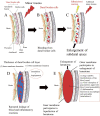Chronic Subdural Hematoma-Evolution of Etiology and Surgical Treatment
- PMID: 36288974
- PMCID: PMC9894619
- DOI: 10.2176/jns-nmc.2022-0207
Chronic Subdural Hematoma-Evolution of Etiology and Surgical Treatment
Abstract
In this paper, I review the historical changes in the etiological concepts and surgical treatments for chronic subdural hematoma (CSDH) across the world and in Japan. I also examine future problems associated with its surgical procedures and medical costs. CSDH was first reported by Wepfer in 1657 as "delayed apoplexy." In 1857, Virchow described the famous concept of so-called "pachymeningitis hemorrhagica interna." He considered that the etiology of CSDH involved inflammation. In 1914, Trotter described the origin of CSDH as traumatic. Currently, CSDH is considered to arise with a first leak of blood from dural border cells after mild trauma. Inflammatory cells are then drawn to the border cell layer. At this point, new membranes form from activated inflammation; then, the hematoma enlarges, promoted by angiogenic factors and new capillaries. In 1883, Hulke reported successful trepanning of a patient with CSDH. Burr holes and craniotomy for removal of the hematoma were subsequently reported, and new methods were developed over the course of several decades around the world. In Japan, after the first report by Nakada in 1938, many Japanese pioneering figures of neurological surgery have studied CSDH. After Mandai reported the middle meningeal artery embolization in 2000, this method is now considered useful as an initial or second treatment for CSDH. However, the age of patients is increasing, so more minimally invasive surgeries and useful pharmacotherapies are needed. We must also consider the costs for treating CSDH, because of the increasing numbers of surgical cases.
Keywords: chronic subdural hematoma; etiology; history; outcome; surgical treatment.
Conflict of interest statement
Author has no conflicts of interest to declare regarding this study or its findings.
Figures


References
-
- Toi H, Kinoshita K, Hirai S, et al. : Present epidemiology of chronic subdural hematoma in Japan: analysis of 63,358 cases recorded in a national administrative database. J Neurosurg 128: 222-228, 2018 - PubMed
-
- Rauhala M, Luoto TM, Huhtala H, et al. : The incidence of chronic subdural hematomas from 1990 to 2015 in a defined Finnish population. J Neurosurg 132: 1147-1157, 2019 - PubMed
-
- Kudo H, Kuwamura K, Izawa I, Sawa H, Tamaki N: Chronic subdural hematoma in elderly people: present status on Awaji Island and epidemiological prospect. Neurol Med Chir (Tokyo) 32: 207-209, 1992 - PubMed
-
- Edlmann E, Holl DC, Lingsma HF, et al. : Systematic review of current randomised control trials in chronic subdural haematoma and proposal for an international collaborative approach. Acta Neurochir (Wien) 162: 763-776, 2020 - PubMed

